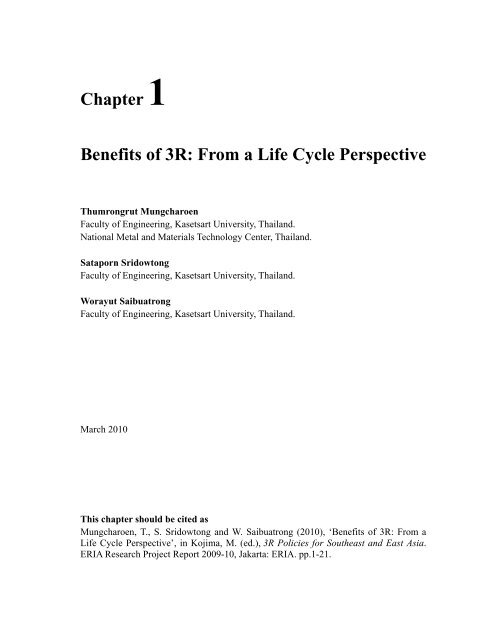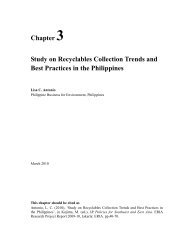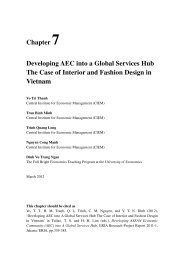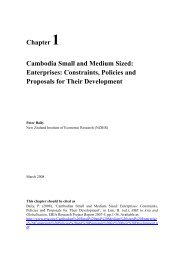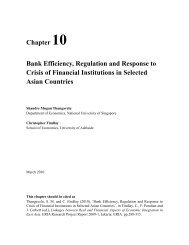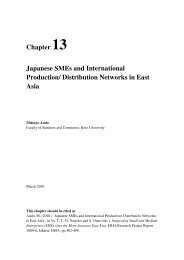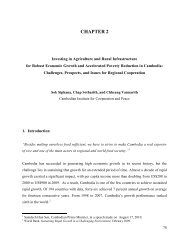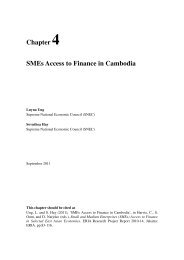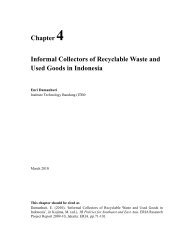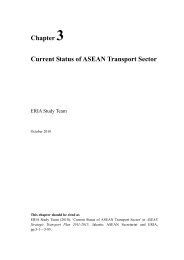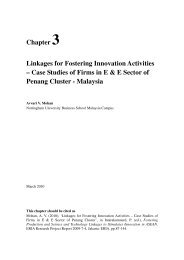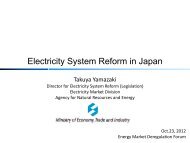Chapter 1 Benefits of 3R: From a Life Cycle Perspective - ERIA
Chapter 1 Benefits of 3R: From a Life Cycle Perspective - ERIA
Chapter 1 Benefits of 3R: From a Life Cycle Perspective - ERIA
Create successful ePaper yourself
Turn your PDF publications into a flip-book with our unique Google optimized e-Paper software.
CHAPTER 1<strong>Benefits</strong> <strong>of</strong> <strong>3R</strong>: <strong>From</strong> a <strong>Life</strong> <strong>Cycle</strong> <strong>Perspective</strong>Thumrongrut Mungcharoen a,b *, Sataporn Sridowtong a , and Worayut Saibuatrong aaFaculty <strong>of</strong> Engineering, Kasetsart University, Bangkok 10900, Thailandb National Metal and Materials Technology Center, Pathumthani 12120, Thailand*E-mail: fengtrm@ku.ac.th, thumrong@mtec.or.th1
ecycled material collection, reprocessing (including auxiliary materials and electricity),transportation, use, and waste management. For the virgin material/product, the life cycle stagesare raw material extraction, processing (including auxiliary materials and electricity),transportation, use, and waste management.3. <strong>Benefits</strong> <strong>of</strong> RecyclingBased on the analysis <strong>of</strong> previous publications and various LCA s<strong>of</strong>tware programs, thissection presents the benefits <strong>of</strong> material recycling focusing on the greenhouse gas emissions andenergy consumption reduction potential.3.1 <strong>Benefits</strong> <strong>of</strong> Recycling: Based <strong>From</strong> Previous PublicationsRecycling <strong>of</strong> material has been analyzed from a life cycle perspective in a number <strong>of</strong>studies over the past 15 years. Global warming impact and total energy consumption <strong>of</strong> recycledmaterials versus virgin materials (including plastic, paper, metal, and glass) are shown in theparagraphs below.For plastic recycling Oil is the basic feedstock <strong>of</strong> plastics. About 4 % <strong>of</strong> crude oil is usedin plastics manufacturing. Recycling <strong>of</strong> plastics can reduce the use <strong>of</strong> raw materials and energyin the virgin plastic production process and also the greenhouse gas emissions originating fromwaste plastics combustion. Littering problems arising from waste plastics would also diminish[5]. Some <strong>of</strong> the previous studies which have reported various benefits <strong>of</strong> plastic recycling arethe following:Molgaard C. (1995) studied the environmental impacts by disposal <strong>of</strong> plastic frommunicipal solid waste (consists mainly <strong>of</strong> HDPE, LDPE, PP, PS, PET and PVC). Theinvestigation performed was the material recycling process containing a section for pre-washing,a section for separation <strong>of</strong> plastic into its generic types, a section for precutting (shredder), asection for cutting (grinder), a section for washing and purification, and a section for re-meltingand palletizing. The greenhouse gases and other air emissions from virgin plastic process andrecycled plastic process are shown in Figure 2. It was found out that recycling <strong>of</strong> plastic frommunicipal solid waste is only environmentally sound if it is separated from its’ generic plastictypes, which makes it possible to produce a recycled plastic with properties comparable to virginplastic [6].4
Figure 2 Greenhouse gases and other air emissions from Virgin plastic process andrecycled plastic process2.4kg or ton /ton plastic1.240.940.210.000.020.102.021.60.800.060.020.01CO2* CO CH4 N2O HC*Virgin plastic process Recycled plastic processNote: * Unit is ton pollutant /ton plasticRoss S. and D. Evans (2003) investigated whether a recycle and reuse strategy for aplastic-based packaging system would substantially reduce also its overall environmental burden.The functional unit for this comparison was the packaging assembly for a 500 liter capacityrefrigerator. This study compared the environmental performance <strong>of</strong> two plastic-based packagingsystems, including (1) virgin material inputs, comprises moulded expanded polystyrene (EPS)components encased in a polyethylene (PE) heat-shrink wrap, and (2) recycling and reuse <strong>of</strong>materials, comprises moulded EPS components fused to a high-impact polystyrene (HIPS)coating sheet and encased in a PE heat-shrink wrap. Environmental burdens over the life-cycle <strong>of</strong>EPS/PE and EPS-HIPS/PE packaging is shown in Figure 3. Results showed that the oilconsumption was lower for the EPS-HIPS/PE shrink-wrap packaging (recycled packaging) thanfor the EPS/PE packaging (virgin packaging). But the figure showed that for both assemblies itwas quite small, being around 10% <strong>of</strong> the total energy consumption. This reinforces our earlierfinding that the consumption <strong>of</strong> energy during transportation is not a major factor across the lifecycle<strong>of</strong> either packaging. Natural gas consumption is significantly less for the recycledpackaging system because recycling avoids materials processing steps high in gas usage. TheGHG emissions <strong>of</strong> the virgin package are more than 50% higher than for the recycled packaging.This is largely because <strong>of</strong> the reduced weight <strong>of</strong> the new package and the avoidance, byrecycling, <strong>of</strong> some highly energy intensive processing steps [7].5
Figure 3 Comparison <strong>of</strong> environmental burdens over the life-cycle <strong>of</strong> EPS/PEand EPS-HIPS/PE packaging for 500 L refrigerators240MJ or kg CO2 eq./ FU180120600Oil consumption NG consumption GHG emission,Virgin materialsRecycled materialsArena U., et. al. (2003) studied life cycle energy used and GHG emissions <strong>of</strong> a plasticpackaging recycling system. The object <strong>of</strong> the study was the Italian system <strong>of</strong> plastic packagingwaste recycling, which was active in 2001. It collected and mechanically recycled the postconsumerPE and PET liquid containers. The phases <strong>of</strong> collection, compaction, sorting,reprocessing and refuse disposal were individually analyzed and quantified in terms <strong>of</strong> energyand material consumptions as well as <strong>of</strong> emissions in the environment as shown in Figure 4. Theresults indicated that the production <strong>of</strong> recycled PET requires a total amount <strong>of</strong> gross energy andGHG emissions less than what the virgin PET requires, depending on whether the process wastes(mainly coming from sorting and reprocessing activities) were sent or not to the energy recovery[8].6
Figure 4 (a) Resource Consumption and (b) GHG Emissions Related to Each SelectedPlastic Waste Management.1,6006g/unit1,200800400kg CO2 eq. /unit53200PET process (a)PET reprocessCrude oil Gas/Condensate CoalPET process(b)PET reprocessNote: All the data refer to the production <strong>of</strong> 1 kg <strong>of</strong> (recycled or virgin) PET flakes and 0.39 kg <strong>of</strong> (recycled orvirgin) PE flakesFor paper recycling. Recycled paper has been typically used as a raw material innewspapers, tissues and core and packing boards. However, these traditional recovery methodsas well as the utilization <strong>of</strong> wood-based construction waste have been intentionally left out <strong>of</strong>this study as the focus was on finding new concepts for the recovery <strong>of</strong> paper [5]. Previousstudies have reported that the benefit <strong>of</strong> paper recycling as the following:Ekvall T. (1999) demonstrated the potential importance <strong>of</strong> key methodological aspects ina <strong>Life</strong> <strong>Cycle</strong> Inventory (LCI) which is carried out to support decisions regarding wastemanagement options for paper, board and pulp products, or regarding the choice betweenprimary and secondary fibres as raw material in these products. Air emissions <strong>of</strong> primary andsecondary fibres for corrugated board production are shown in Figure 5. It showed that theemissions from the life cycle <strong>of</strong> the corrugated board <strong>of</strong> recycled fibres were less than those <strong>of</strong>virgin fibres due to the avoided emissions from the production <strong>of</strong> material replaced by fibresfrom recycled cartons [9].7
Figure 5 Air emissions <strong>of</strong> virgin fibres and recycled fibres for corrugated board6g / kg <strong>of</strong> corrugated board5320SO2Virgin fibresNOxRecycled fibresPickin J., et. al. (2002) provided a comprehensive investigation <strong>of</strong> total GHG emissionfrom the paper cycle in Australia, from forest through to landfill. He also assessed theeffectiveness <strong>of</strong> various waste management options to reduce GHG emission from paper.Recycling is also beneficial, and is <strong>of</strong> particular interest from a management perspective becauseit can be controlled by the pulp and paper industry. This analysis modeled GHG emissions fromthe lifecycle <strong>of</strong> a ton <strong>of</strong> paper under a range <strong>of</strong> conditions for recycling (no recycling, 30%recycling and 60% recycling). Figure 6 demonstrates the effect <strong>of</strong> paper recycling at differentrates. Results found that GHG emissions were reduced from 6.5 t <strong>of</strong> CO 2 equivalent per ton <strong>of</strong>paper with no recycling to 4.4 t with 60% recycling [10].Figure 6 Total life cycle GHG emissions at different paper recycling rates.8,000kg CO2 eq./ton6,0004,0002,0000No Recycling 30% Recycling 60% RecyclingFor metal recycling. Metal recycling has a long history. Scrap metal is a valuable rawmaterial and its quality does not degrade during recycling. Nearly 98 % <strong>of</strong> the cans belonging to8
the deposit and refund system are recycled, but only about half <strong>of</strong> the metal packaging isrecycled. Recycling <strong>of</strong> metal waste can reduce the environmental impacts from the miningindustry, the space needed at landfill and the emissions originating from landfill sites. A lot <strong>of</strong>energy can also be saved by recycling metals compared with the use <strong>of</strong> virgin metals. The energysaving in steel- and sheet tin packaging manufacture is 75 % and in aluminium packaging it is95 % [5]. Some <strong>of</strong> the previous studies on the benefit <strong>of</strong> metal recycling are the following:W. Lea (1996) studied energy saving <strong>of</strong> recycled aluminum compared to primaryaluminum. The focus <strong>of</strong> this study was to address these assumptions and to determine the degree<strong>of</strong> energy saving achieved through recycling. Comparison <strong>of</strong> unit energies for primary andsecondary processing <strong>of</strong> aluminum is shown in Figure 7. The result showed that secondaryaluminum had higher avoided energy value because it required much less energy to recycle thanto newly produce from virgin material [11].Gatti B., et al. (2008) studied the influence <strong>of</strong> aluminum recycling rate on the LCI <strong>of</strong>aluminum beverage cans in Brazil. The recycling rate <strong>of</strong> 36% (by weight) corresponded to thepercentage <strong>of</strong> aluminum recycled from the domestic consumption <strong>of</strong> primary aluminum in 2004,while 89% (by weight) represented the rate <strong>of</strong> aluminum cans recycled from the total amount <strong>of</strong>cans produced in Brazil in 2003. Results showed that the recycling balance was always positivedue to the importance <strong>of</strong> the stages that preceded the packaging production and the problem <strong>of</strong>increasing the municipal waste volume. The advantages <strong>of</strong> the recycling are obviouslyconcentrated on the parameters related to the primary aluminum production and to the packagedisposal. The verified benefits <strong>of</strong> the recycling increase with the recycling rate enhancement[12].Figure 7 Comparison <strong>of</strong> unit energies for primary and secondary processing <strong>of</strong> Al200193150GJ/ t10050041.55.5 5.4 0.5 2.1Refining Processing Procurement & transportPrimary processingSecondary 9 processing
Johnsona J., et al. (2008) studied the energy use to produce 1 ton <strong>of</strong> austenitic (i.e.,nickel-containing) stainless-steel slab under two scenarios: (1) ‘‘Maximum Recycling’’ scenario:calculates the energy used if demand is completely met from recycled material, and (2) the‘‘Virgin Production’’ scenario: examines stainless-steel production in the absence <strong>of</strong> scrap.Energy required to produce 1 ton <strong>of</strong> austenitic stainless steel throughout its entire life cycle isshown in Figure 8. The results showed that approximately 22,500 MJ/ton for recycled stainlesssteel, and 80,000 MJ/ton for virgin production. By comparing these results to the virginproduction scenario, it was determined that the recycling <strong>of</strong> austenitic stainless steel required33% <strong>of</strong> primary energy. If complete recycling <strong>of</strong> stainless steel is to occur (maximum recycling),which is not currently possible due to scrap availability, global energy use would be 67% lessthan the virgin production [13].Figure 8 Energy required to produce austenitic stainless steel throughout life cycle90,00067,500MJ/t <strong>of</strong> stainless steel45,00022,5000Virgin stainless steelRecycled stainless steelRenewable Propane NG Nuclear Petroleum CoalFor glass recycling. The main raw materials <strong>of</strong> virgin glass are sand, soda, and lime inwhich all are melted into glass at 1500 degree C. Virgin glass is still widely used however it isincreasingly being replaced by recovered glass. Almost all <strong>of</strong> the glass bottles belonging to thedeposit system are recycled and end up being either refilled or crushed for reprocessing. Thereare many advantages <strong>of</strong> glass recycling. Glass can be recycled and used over and over withoutimpairing the quality. Therefore natural resources and expensive raw materials are saved. Theuse <strong>of</strong> recycled glass also saves energy because it is easier to melt than the virgin raw materials[5]. Some <strong>of</strong> the previous studies conducted about the benefits <strong>of</strong> glass recycling are thefollowing:10
Vellini M.and M. Savioli. (2008) applied this methodology to a particularly energyintensiveproduction process, i.e. glass production for the manufacture <strong>of</strong> drink containers, inorder to carry out a thorough environmental and energy analysis <strong>of</strong> the recycled and reused glasscontainers. The production <strong>of</strong> glass containers was compared to the production <strong>of</strong> polyethyleneterephthalate (PET) containers to determine the optimal percentage <strong>of</strong> glass recycling for theminimization <strong>of</strong> energy consumption and pollutant emissions. Two cases were studied: Case 1glass production and usage with 25% reuse and 60% recycle; and Case 2 glass production andusage with 80% reuse and 16% recycle. Based on the results, it clearly showed that the benefits<strong>of</strong> recycling were unquestionably good. It helped not only on the general improvement <strong>of</strong> theenergy and technological processes but also it caused substantial reduction <strong>of</strong> the environmentalimpacts (with the exception <strong>of</strong> the carbon monoxide emissions which was not changed due to theincrease <strong>of</strong> transport operation), which were even more valuable for those products that cannotbe contained in PET bottles, such as wines and other alcoholic beverages. [14].Some <strong>of</strong> other previous studies on the benefits <strong>of</strong> material recycling are the following:Amelia L., et al. (1996) studied and compared the relative environmental impacts <strong>of</strong> arecycling system (incorporating the curbside collection <strong>of</strong> recyclable materials and theirsubsequent use by manufacturers), with a waste disposal system (in which the waste is disposedto landfill and primary raw materials are used in manufacture), using the LCA. GHG emissions<strong>of</strong> waste disposal and material recycling are shown in Figure 9. The result showed that the wastedisposal systems generally made a larger contribution to global warming than the recyclingsystems. For aluminum, the recovery and use <strong>of</strong> secondary aluminum contributed to a saving <strong>of</strong>95%, which was the largest for all materials, both in absolute and percentage terms. There werealso large savings involved in recycling glass and paper, 44% and 91%, respectively. However,the difference is minimal for steel (5%). The savings for plastics are 80%, 40% and 66% forHDPE, PET and PVC, respectively [15].11
Figure 9 GHG emissions <strong>of</strong> waste disposal and materials recycling600kg CO2 eq./ton4503001500Aluminium* Glass* Paper Steel HDPE PET PVCWaste disposal RecyclingNote: * Unit is ton CO 2 eq./ton materialKorhonen M. and H. Dahlbo. (2007) presented the material recovery subproject and moreprecisely the GHG emission reduction potential results. The amount <strong>of</strong> GHG emission savings,calculated as carbon dioxide equivalent, for different waste recycling materials are presented inFigure 10. The results showed that material recycling had the potential to reduce GHG emissionin all material groups. The highest potential for emission reduction existed for recycling <strong>of</strong>plastic, textile, metal, paper and glass respectively. However, the high GHG reduction potentialfor plastic waste recycling only existed when virgin plastics were replaced by recycled plastics.Replacing other materials produces less significant reduction [5].12
Figure 10 GHG emissions <strong>of</strong> reference product and recycled productper ton <strong>of</strong> produced product.3,200kg CO2 eq./ton2,4001,6008000Glass Plastic Metal Textile PaperReference productRecycled productChen T.and C. Lin. (2008) quantified and assessed the level <strong>of</strong> GHG contribution foreach type <strong>of</strong> treatment method being practiced in Taipei City’s regional household wastemanagement process. Reduction in GHG emissions from using recycled materials instead <strong>of</strong> rawmaterials were presented in Figure 11. Recycling created the least contribution <strong>of</strong> GHGemissions out <strong>of</strong> all waste management solutions. This is because <strong>of</strong> the usage <strong>of</strong> recycledmaterials instead <strong>of</strong> virgin materials in the manufacturing process. It greatly reduced not only thedemand for energy but also the non-energy GHG emissions in the manufacturing process.Recycling <strong>of</strong> paper products in particular helped with forest carbon sequestration [1].Figure 11 GHG emissions reduction from using recycled materials instead <strong>of</strong> rawmaterials.TiresGlass containersOther plastic productsPET bottlesMetal cansUsed clothing (textiles)Paper containersPaper-0.8 -0.6 -0.4 -0.2 0kg CO2 eq./ kg materilas13
DC-Environment (2008) determined the values <strong>of</strong> the main environmental indicators foreach primary packaging material. This study aimed to compare the differences between thedifferent primary package options for beer. Functional unit as defined "Beer production <strong>of</strong> 100liter <strong>of</strong> beer and full life cycle <strong>of</strong> the packaging associated." The materials studied were PETbottles, glass long neck bottles, aluminum cans, and steel cans (all <strong>of</strong> them are 500ml beerpackaging options). Results found that the production <strong>of</strong> raw materials for primary packagingproduction was one <strong>of</strong> the most important phases <strong>of</strong> the full LCA. A high recycling ratemeasurably reduced the impact on all indicators. At a recycling rate around 80% for eachpackaging material, aluminium cans, steel cans and PET bottles were roughly equivalent inimpact reduction [16].The benefits <strong>of</strong> materials recycling in terms <strong>of</strong> total energy use and GHG emissions asmentioned in the previous studies reviewed are summarized in Table 1. The results indicate thatproducing materials from recycled resources is less energy intensive and has less GHG emissionsthan from virgin resources. Material recycling can also decrease both the direct and indirectGHG emissions. Direct emissions are decreased when waste is neither disposed <strong>of</strong> at landfillsnor treated by other methods such as combustion. Indirect emissions can be cut down bydecreasing the energy consumption both in acquiring and producing raw materials and also inmanufacturing the product itself [5].3.2 <strong>Benefits</strong> <strong>of</strong> Recycling: Using Several LCA S<strong>of</strong>tware ProgramsManufacturing processes including recycling are <strong>of</strong>ten very complex and convoluted.Additionally LCA is <strong>of</strong>ten required input-output data intensively. LCA s<strong>of</strong>tware program canhelp to structure the model scenario, display the process chains and also present and analyze theresults [17]. Several commercial and public-domain LCA s<strong>of</strong>tware programs are available.Among those are “SimaPro” from Pre’ Consultants, “GaBi” from PE International, and “JEMAI-LCA Pro” from Japan Environmental Management Association for Industry (JEMAI) whichfocus on the evaluation <strong>of</strong> industrial and agricultural production processes, while LCA designsupporting tools such as “BEES” from National Institute <strong>of</strong> Standards and Technology (USA)and “ATHENA” from National Agency for Higher Education (Sweden) focus on the evaluation<strong>of</strong> specific building materials and components [18]. SimaPro, GaBi, and JEMAI-LCA Pro areavailable at National Metal and Materials Technology Center and several universities inThailand. The databases in those three s<strong>of</strong>tware programs include production processes <strong>of</strong> virgin14
and recycled materials. The details <strong>of</strong> the databases in those LCA s<strong>of</strong>tware programs formaterials recycling are summarized in Table 2.Results <strong>of</strong> life cycle GHG emissions <strong>of</strong> plastics recycling (from recycling process), virginplastics, and recycled plastics (including: PVC, PS, PP, PET and PE) obtained from LCAs<strong>of</strong>tware databases are presented in Figure 12. <strong>Life</strong> cycle GHG emissions from recycling <strong>of</strong>others materials (including: glass, cardboard, paper, iron and aluminum) obtained from LCAs<strong>of</strong>tware databases are presented in Figure 13.As shown in Figures 12 and 13, the results demonstrated that recycling <strong>of</strong> materials hasthe potential to reduce GHG emissions and energy consumption. It is beneficial to substitutevirgin material with recycled material because the emissions from virgin material acquisition andproduction can be avoided. In most cases, the replacement <strong>of</strong> virgin materials by recycledmaterials decreases the use <strong>of</strong> net energy and thus the GHG emissions originating from energyproduction and usage also decrease. GHG emissions can also be reduced by avoiding the use <strong>of</strong>virgin materials which produce emissions directly in the extraction phase. However, in somecases, the benefits <strong>of</strong> recycling are less if too much energy is required during transportation andrecycling process [5].15
Table 1: Overview <strong>of</strong> LCA studies for material recyclingReference RecycledmaterialsVirgin materials Total energy a GHGemissions aHDPE, LDPE, Virgin: (HDPE,Molgaard C. ,1995PP, PS, PET, LDPE, PP, PS,[6]PVCPET ,PVC)- R
Table 2: Databases <strong>of</strong> materials recycling in some LCA s<strong>of</strong>tware programsLCAs<strong>of</strong>twareSimaPro7.1.8JEMAI Pro[22]GaBi 4.0[23]Materials recyclingDatabase PVGlas PapePS PP PET PECs rIron AlRER (Ecoinvent) [19]BUWAL 250 [20]FAL (IDEMAT)[21]Japanese database - Figure 12 <strong>Life</strong> <strong>Cycle</strong> GHG emissions from plastics recycling, virgin plastics, and recycledplastics (GHG Recycled plastic = GHG Plastic recycling - GHG Virgin plastic )JEMAIProSimaPro(B250)SimaPro(RER)JEMAIProSimaPro(B250)SimaPro(RER)SimaPro(B250)SimaPro(RER)JEMAIProSimaPro(B250)SimaPro(RER)SimaPro(RER)PVC recyclingVirgin PVCRecycled PVCPVC recyclingVirgin PVCRecycled PVCPVC recyclingVirgin PVCRecycled PVCPS recyclingVirgin PSRecycled PSPS recyclingVirgin PSRecycled PSPS recyclingVirgin PSRecycled PSPP recyclingVirgin PPRecycled PPPP recyclingVirgin PPRecycled PPPET recyclingVirgin PETRecycled PETPET recyclingVirgin PETRecycled PETPET recyclingVirgin PETRecycled PETPE recyclingVirgin PERecycled PE-3.00E+00 -2.00E+00 -1.00E+00 0.00E+00 1.00E+00 2.00E+00 3.00E+00kg CO2 eq./kg materials17
Figure 13 <strong>Life</strong> <strong>Cycle</strong> GHG emissions from materials recycling, virgin materials andrecycled materials (GHG Recycled material = GHG Material recycling - GHG Virgin material )SimaPro(RER) JEMAI Pro GaBiAl recyclingVirgin AlRecycled AlAl recyclingVirgin AlRecycled AlAl recyclingVirgin AlRecycled AlSimaPro(FAL) JEMAI ProSimaPro(B250)SimaPro(RER)SimaPro(RER)SimaPro(B250) JEMAI ProSimaPro(RER)-1.50E+01 -1.00E+01 -5.00E+00 0.00E+00 5.00E+00 1.00E+01 1.50E+01 2.00E+01kg CO2 eq./kg materialsGlass recyclingVirgin glassRecycled glassGlass recyclingVirgin glassRecycled glassGlass recyclingVirgin glassRecycled glassGlass recyclingVirgin glassRecycled glassCardboard recyclingVirgin cardboardRecycled cardboardPaper recyclingVirgin paperRecycled paperPaper recyclingVirgin paperRecycled paperIron recyclingVirgin ironRecycled iron-1.50E+00 -1.00E+00 -5.00E-01 0.00E+00 5.00E-01 1.00E+00 1.50E+00 2.00E+00kg CO2 eq./kg materials18
4. ConclusionThe <strong>3R</strong> measures especially resource recycling <strong>of</strong> various materials are presented in thisstudy. These can contribute greatly to the eco-image <strong>of</strong> waste management. The quantitativecomparison using LCA study between each scenario shows that the recycling option is alwaysenvironmentally preferable. Material recycling has the potential to reduce greenhouse gasemission, energy consumption, and other environmental impacts throughout the whole life cyclein all material groups. Due to the substitution <strong>of</strong> virgin materials with recycled materials, theemissions from extraction and manufacturing <strong>of</strong> products from virgin materials can be avoided.GHG emissions for the whole life cycle from raw materials extraction, materials processing,products manufacturing, usage, and disposal including transportation (cradle-to-grave approach)can be reduced in situations where the waste materials and/or waste products are recycled instead<strong>of</strong> being combusted, treated or disposed <strong>of</strong> at disposal sites. The results <strong>of</strong> the study clearly showthat <strong>3R</strong> measures including resource recycling have a net gain on environmental benefits andperform better than the end-<strong>of</strong>-pipe treatment methods such as landfill and incineration in terms<strong>of</strong> life cycle reduction <strong>of</strong> greenhouse gas emission, energy consumption, and otherenvironmental impacts.19
ReferenceChen T. and C. Lin. 2008. “Greenhouse gases emissions from waste management practices using<strong>Life</strong> <strong>Cycle</strong> Inventory model”, Journal <strong>of</strong> Hazardous Materials, 155 (2008) 23–31.Spire Research and Consulting Pte Ltd. 2006. Recycling for the Next Generation, Howimpending recycling legislation will change the way businesses work.Apisitpuvakul W., et al. 2008. “LCA <strong>of</strong> spent fluorescent lamps in Thailand at various rates <strong>of</strong>recycling”, Journal <strong>of</strong> Cleaner Production, 16 (2008) 1046-1061.Curran M.A. 1997. Environmental <strong>Life</strong> <strong>Cycle</strong> Assessment. New York: McGraw-Hill.Korhonen M. and H. Dahlbo. 2007. Reducing Greenhouse Gas Emissions byRecycling Plastics and Textiles into Products. The Finnish Environment 30/2007.Molgaard C. 1995. “Environmental impacts by disposal <strong>of</strong> plastic from municipal solidwaste”, Resources Conservation and Recycling, 15 (1995) 5l-63.Ross S. and D. Evans, 2003. “The environmental effect <strong>of</strong> reusing and recycling a plasticbasedpackaging system”, Journal <strong>of</strong> Cleaner Production, 11 (2003) 561–571.Arena U., et al. 2003. “<strong>Life</strong> cycle assessment <strong>of</strong> a plastic packaging recycling system”. Int JLCA 8 (2003) 92–98.Ekvall T. 1999. “Key methodological issues for life cycle inventory analysis <strong>of</strong> paperRecycling”, Journal <strong>of</strong> Cleaner Production, 7 (1999) 281–294.Pickin J., et al. 2002. “Waste management options to reduce greenhouse gas emissionsfrom paper in Australia”, Atmospheric Environment, 36 (2002) 741–752.Lea W. 1996. “Plastic incineration versus recycling: a comparison <strong>of</strong> energy and landfillcost savings”, Journal <strong>of</strong> Hazardous Materials, 47 (1996) 296-302.Gatti B., et al. 2008. “Recycling <strong>of</strong> aluminum can in terms <strong>of</strong> <strong>Life</strong> <strong>Cycle</strong> Inventory (LCI)”, Int JLCA, 13 (2008 ) 219 –225.Johnsona J., et al. 2008. “The energy benefit <strong>of</strong> stainless steel recycling”, Energy Policy, 36(2008) 181–192.Vellini M. and M. Savioli. 2008. “Energy and environmental analysis <strong>of</strong> glass containerproduction and recycling”, Energy (2008) 1–7.Amelia L., et al. 1996. “<strong>Life</strong> cycle assessment and economic evaluation <strong>of</strong> recycling: acase study”, Resources Conservation and Recycling, 17 (1996) 75-96.DC-Environment. 2008. <strong>Life</strong> <strong>Cycle</strong> Assessment <strong>of</strong> four beer packaging options: glass bottle, PETbottle, aluminium can & steel can.Unger N., et al. 2000. General requirements for LCA s<strong>of</strong>tware tools. Institute <strong>of</strong> WasteManagement, BOKU – University <strong>of</strong> Natural Resources and Applied <strong>Life</strong> Sciences,Vienna, Austria.Fujimoto S., et al. 2000. Evaluation <strong>of</strong> recycling technologies <strong>of</strong> concrete related materials: Toward reduction <strong>of</strong> waste and CO 2 emission. JSPS Research Fellow, Graduate School <strong>of</strong>Engineering, Department <strong>of</strong> Architecture, University <strong>of</strong> Tokyo.Ecoinvent. 2003. “Final Report Eco-invent 2000”, SimaPro 7.0, Amersfoort.20
BUWAL 250. 1996. Okoinventare fur Verpackungen. Schriftenreihe Umwelt, Bern.Franklin Association. 1998. Franklin USA 98 database. Source: www.fal.comJapan Environmental Management Association for Industry. 2002. Japan life cycleinventory database.PE Europe GMBH. 2003, GaBi 4.0 manual.21


